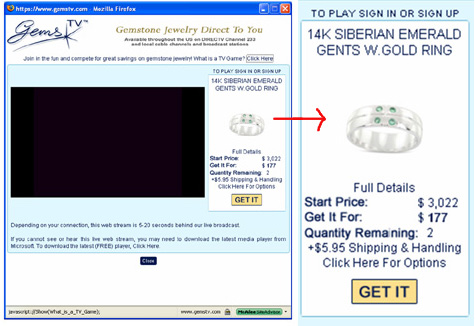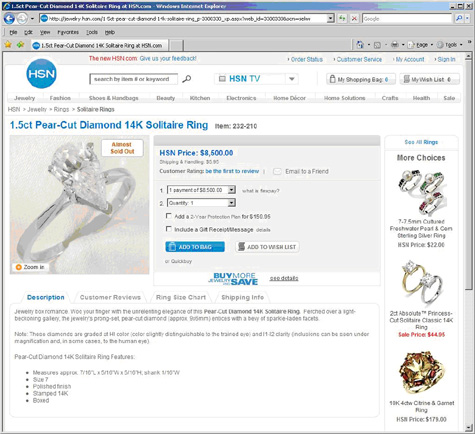TV Shopping for Jewelry—
Get It While They Last!
Home shopping channels reach an estimated 90 million households in the U.S. A good chunk of their sales involves jewelry. They thrive on speed and excitement, and sometimes details get lost in the hype. One of these details is Valuation.
TV shopping puts out a fast-paced pitch for a quickly changing target. The hostess oohs and aahs, puts the ring on her finger, and a close-up shows that sparkling stone big as your screen. Satisfied customers call in to praise the beauty of the current offering and testify to their happiness with former purchases. The price sounds like a bargain, the clock is ticking, and there are only a few left!
Jewelry Television™, one of the biggest players, sells only jewelry, 24 hours a day. They claim to be the largest retailer of loose gemstones and they count on moving merchandise quickly.
Here’s a typical offering from JTV’s “Fast & Furious” show special:
A peridot ring for $99, which the hostess says contains $288 worth of gold. She then adds matching earrings, valued at $149, offering all three pieces for the same $99 price. The replacement cost is given as $650. A counter onscreen shows how much time is left to make the purchase, the seconds ticking away.
Some shows, such as GemsTV™, specialize in an auction format. A piece is offered, in limited quantity, at a “start price”—and the price goes down as pieces are sold. In the end all buyers pay the last (lowest) price, but if you wait to see how low it will go, you may be too late and they’ll sell out.
Like many shopping shows, GemsTV™ has a Web site. Two screen shots are shown below. The block that appears here as black would, online, be showing live broadcast of the TV show. The section to the right shows a recent sale.


In these examples, a ring that began at $5,558 sold for $359. Another that started at $3,022 went for $177.
We can assume that the sale price is closer to the jewelry’s true value. But if an appraisal is included with the sale, what valuation does it give???
Home Shopping Network is the #1 shopping channel in terms of revenue. HSN® also has a Web site. TV viewers are told: If the line is busy, go to our Web site.
We checked out some of the higher-priced offerings.

The 1.5ct pear-shaped diamond in this ring is described as H-I color (some color visible to the naked eye) and I1-I2 clarity (inclusions may be visible to the naked eye). Though this is not a high-quality diamond, the difference in price between H and I color is still significant, as is the difference between I1 and I2 clarity, so this loose grading builds in some “flexibility” in valuation. No information is given on cut proportions, which greatly affect a diamond’s value. Such vague or missing descriptions are typical.
Based on the descriptive information available, our calculations show that this ring could retail for anywhere between $3400 and $8900. If the piece is at the high end of quality, the selling price of $8500 was a good deal; if it’s at the low end, the buyer might have paid more than twice its retail value.
The Web site is also a good place to check information. On the air, the enthusiasm of the host takes over. Cultured pearls are called natural. The host says, “The gold alone is worth $900!”. He gives a replacement cost of maybe triple the price. One host said of the tiny diamonds surrounding a central pearl, “Look how well matched they are!” Such comments raise the energy for fast TV sales, but on the Web site they don’t appear.
Reasonable prices seem to be generally the case. One manufacturer who contracted with a shopping channel for a large number of pieces said the jewelry was offered to viewers at bargain prices and sold quickly.
He also noted that the shopping channel never loses money. If an item isn’t selling fast enough, the show moves on to something else. If an item sells too fast, they’ll continue taking orders — but they don’t order more product from the supplier. They just send a letter to the potential customer saying, “Sorry, we’re sold out. Next time buy sooner.”
The Valuation Issue
Unlike eBay jewelry sites, which we discussed last month, TV shopping does not seem to use high appraisal valuations as an inducement to buy. (A replacement-cost document may accompany the purchase, but it’s not an advertising lure.) Instead, a high “start price” — like a host’s enthusiam or the testimonials of previous buyers — suggests to viewers that this is a great deal.
The JTV site offers an appraisal for $50, but it does not name the appraiser or lab it comes from (reminder to insurers: not all labs or appraisers are reliable!) and it doesn’t give the appraised valuation. Perhaps the caution about announcing valuations is because the airwaves, unlike the Internet, are controlled by the FCC.
Some on-air hosts are said to hold “Accredited Jewelry Professional” certification. This sounds impressive but comes after just three classes by mail aimed at teaching retailers how to talk about jewelry to customers. (It is not a gemologist degree and does not educate one to appraise jewelry or assign valuations.) The title is meant to give the viewer confidence in the seller.
The customer is similarly reassured by the offer of an appraisal and the money-back guarantee. Buyers are unlikely to seek another appraisal after the purchase — unless the insurer asks for one—so the accuracy of the jewelry’s description or valuation may never be challenged.
We looked at some of the major shopping shows, but other shows, including local ones, are always springing up. Abuses are more likely as the shows become more common and more competitive. The home shopping shows we viewed generally sell jewelry at reasonable prices, much of it low-priced jewelry that usually wouldn’t be separately insured. Only the occasional high-priced item would be up for scheduling.
However, as always with high-value jewelry, the insurer must be vigilant.
A Final Cautionary Tale
One jeweler recently notified us of an egregious case of inflated valuation. A customer brought in for appraisal a ring she’d purchased on a TV auction. It had come with an appraisal, from a Bangkok lab, valuing it at a stratospheric $68,750. The U.S. jeweler, who is a Graduate Gemologist and Certified Insurance Appraiser™, prepared a detailed appraisal on JISO 78. The true valuation, the realistic current replacement cost, was $2,000.
$68,750 vs. $2,000! Let that flagrant valuation discrepancy remind you of the importance of getting a second appraisal, from a reputable gemologist, on all high-value jewelry.
FOR AGENTS & UNDERWRITERS
For all high-value jewelry, ask for a second appraisal on JISO 78/79, written by a Graduate Gemologist who is also a Certified Insurance Appraiser™.
Always get a copy of the sales receipt — expecially for jewelry bought from TV sales and auctions. TV sellers may make claims about high value, and the reverse auctions may start at a high price, but the merchandise is generally low-quality jewelry at a low price.
FOR ADJUSTERS
Be suspicious of appraisals, lab reports, or other documentation supplied by the seller. Often crucial information is left out, such as cut information and gem treatments.
For example, one TV shopping show states, in a general description of diamond on its Web site, that diamonds are often irradiated. It’s probably true that the diamonds they sell are irradiated. However, this treatment lowers a diamond’s value and should be specifically stated on the appraisal.
If there is a large discrepancy between purchase price and valuation, the purchase price is a better indication of the jewelry’s true value.
In the absence of a detailed appraisal on JISO 78/79, make every effort to determine where the jewelry was purchased. This information can often help pin down details of the jewelry’s qualities and lead to a realistic valuation.
©2000-2024, JCRS Inland Marine Solutions, Inc. All Rights Reserved. www.jcrs.com

